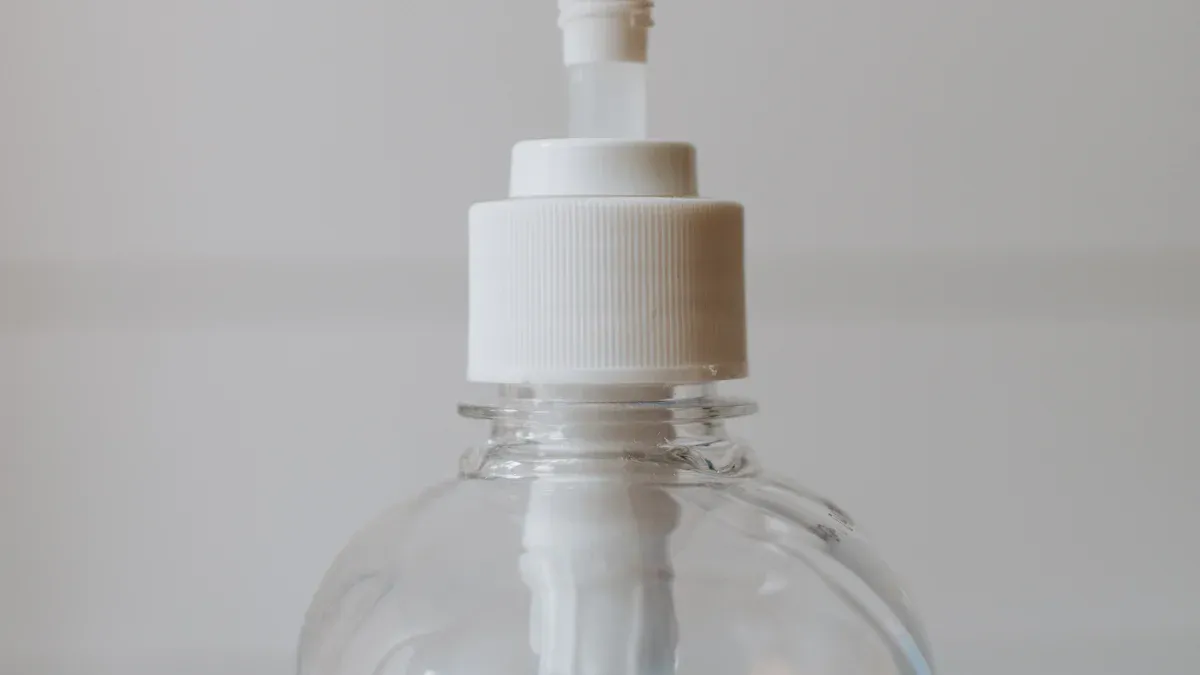
A lotion pump can fail due to simple issues that you can fix yourself. Clogs often block the lotion pump dispenser, while airlocks disrupt the flow. Thick lotion may strain the lotion pump mechanism. If you use an Airless Lotion Pump, the design may prevent air-related failures. Consult your lotion pump supplier for durable options.
Key Takeaways
- Clean your lotion pump often to stop clogs. Wipe the tip after using it and soak the pump in warm water if it gets stuck.
- Keep lotion bottles in a cool, dry spot to keep them good. Stay away from humid places to stop thickening and help it come out easily.
- Pick the right pump for how thick your lotion is. For thicker lotions, use pumps with bigger openings and stronger parts to avoid problems.
Common Reasons for Lotion Pump Failure

Clogged Pump Mechanism
A clogged pump mechanism is one of the most common reasons your lotion pump stops working. Over time, dried lotion can accumulate inside the pump nozzle or the internal tube. This buildup blocks the flow of lotion, making it difficult or impossible to dispense. If you notice resistance when pressing the pump or no lotion coming out, a clog is likely the issue.
To prevent clogs, always wipe the nozzle after each use. This simple habit keeps the opening clear and ensures smooth operation. If the pump is already clogged, you can soak it in warm water to dissolve the dried lotion. A toothpick or a small pin can also help dislodge stubborn blockages.
Airlock in the Pump Tube
An airlock occurs when air gets trapped inside the pump tube, disrupting the flow of lotion. This often happens when the bottle is nearly empty or if the pump was not primed correctly during manufacturing. You might notice the pump making a “sputtering” sound or dispensing only small amounts of lotion.
To fix an airlock, remove the pump from the bottle and press it several times while holding it under water. This process forces the air out and restores the vacuum needed for proper dispensing. Reattach the pump to the bottle, and it should work as expected.
Broken or Misaligned Spring
The spring inside the pump mechanism plays a crucial role in its functionality. It allows the pump to return to its original position after each press. If the spring breaks or becomes misaligned, the pump may feel loose or fail to dispense lotion altogether.
Inspect the pump to check for visible damage to the spring. If the spring is misaligned, you can try to reposition it carefully. However, if the spring is broken, replacing the pump is often the best solution. Many lotion pumps are designed to be disposable, so finding a replacement is usually straightforward.
Lotion Too Thick for the Pump
The thickness of your lotion can also affect how well the pump works. Lotions with high viscosity require more force to pass through the pump nozzle. If the pump is not designed to handle thick lotions, it may struggle or fail entirely.
Studies show that the viscosity of lotions impacts pump functionality by altering the lotion’s microstructure during dispensing. High-viscosity lotions experience changes in their yield stress and flow properties, especially at low shear rates. This can make it harder for the pump to dispense the lotion effectively.
To address this issue, you can dilute the lotion slightly with a compatible liquid, such as water or a carrier oil, depending on the product’s formulation. Alternatively, consider switching to a pump specifically designed for thicker lotions. Consulting your lotion pump supplier can help you find a more suitable option.
Quick Fixes for a Stuck or Broken Lotion Pump

Unclogging the Pump
When your lotion pump stops working due to a clog, you can fix it with a few simple steps. Dried lotion often blocks the nozzle or internal tube, preventing smooth dispensing. To restore functionality:
- Use pliers to grip the smooth part of the pump top securely.
- Twist the nozzle in the direction of the arrow marked “OPEN” while keeping the smooth part steady.
- Continue twisting until the stem pops up. Once it does, press the pump to check if lotion flows properly.
If the clog persists, soak the pump in warm water for 10-15 minutes. This softens the dried lotion, making it easier to remove. For stubborn blockages, use a toothpick or pin to clear the nozzle. Regular cleaning after each use can prevent future clogs.
Fixing an Airlock
An airlock can disrupt the flow of lotion, causing sputtering or uneven dispensing. You can fix this issue by removing the trapped air. Start by detaching the pump from the bottle. Submerge the pump in a bowl of water and press it repeatedly. This action forces the air out of the tube and restores the vacuum needed for proper operation.
Once the airlock clears, reattach the pump to the bottle. Test it by pressing the pump a few times. If the problem persists, repeat the process to ensure all air is removed.
Realigning or Replacing the Spring
A misaligned or broken spring can make your lotion pump feel loose or unresponsive. To fix a misaligned spring, carefully disassemble the pump. Inspect the spring and reposition it so it sits correctly in its housing. Reassemble the pump and test its functionality.
If the spring is broken, replacing the pump is often the best solution. Many lotion pumps are designed for single use, so finding a replacement is usually straightforward. Look for a pump compatible with your lotion bottle to avoid further issues.
Adjusting Lotion Consistency for Better Flow
Thick lotions can strain the pump mechanism, making it difficult to dispense. If your lotion is too thick, you can adjust its consistency for smoother flow. Add a small amount of water or a compatible carrier oil to the lotion. Mix thoroughly until the lotion reaches a pourable consistency.
Alternatively, consider switching to a pump designed for high-viscosity products. These pumps have wider nozzles and stronger mechanisms, making them better suited for thicker lotions. Consult your lotion pump supplier to find the right option for your needs.
Preventing Future Lotion Pump Issues
Regular Cleaning and Maintenance
Keeping your lotion pump clean ensures it works smoothly and lasts longer. Residual lotion can dry inside the pump, leading to clogs and reduced functionality. Regular cleaning removes buildup and prevents these issues. You can clean the pump by soaking it in warm water and using a small brush to scrub the nozzle and tube.
Clinicians and maintenance experts emphasize the importance of cleaning protocols for optimal performance. The table below highlights key preventative measures:
| Preventative Measure | Description |
|---|---|
| Regular Cleaning | Essential for removing residual fluid and ensuring device operability. |
| Clinician Education | Training on proper cleaning and handling can reduce repair needs. |
| Maintenance Protocols | Adherence to protocols ensures optimal performance and longevity. |
By following these practices, you can reduce the need for repairs and extend the life of your lotion pump.
Proper Storage of Lotion Bottles
Storing your lotion bottles correctly minimizes pump issues and preserves the lotion’s quality. Improper storage, such as leaving bottles in humid or warm areas, can cause the lotion to thicken or degrade. This affects the pump’s ability to dispense lotion effectively.
Follow these best practices for storage:
- Store cosmetics in a cool and dry place to prevent breakdown and loss of effectiveness.
- Avoid the bathroom for storage due to humidity and warmth.
- Keep products away from air and light to prevent oxidation.
- Use proper storage containers like airtight jars and pump bottles.
- Maintain cleanliness to prevent bacteria growth.
- Regularly check expiration dates and dispose of expired products.
- Consider refrigerating certain products to prolong shelf life.
These steps help maintain the lotion’s consistency and ensure the pump operates without strain.
Selecting the Right Pump for Your Lotion
Choosing the right pump for your lotion prevents many common issues. Pumps are designed for specific lotion types, so selecting one that matches your product’s viscosity is crucial. For thicker lotions, opt for pumps with wider nozzles and stronger mechanisms.
Surveys show that regular maintenance and proper pump selection significantly reduce failures over time. The table below outlines survey types and their purposes:
| Survey Type | Frequency | Purpose |
|---|---|---|
| Annual Survey | Once a year | Update records, document operating conditions, and produce a survey report. |
| Monthly Survey | Once a month | Follow up on annual survey findings, typically less extensive. |
| Weekly Records | Once a week | Note any abnormalities in pump operation. |
| Daily Log | Daily | Routine operating procedure for operators and maintenance departments. |
By choosing the right pump and maintaining it regularly, you can enjoy hassle-free lotion dispensing for a long time.
Lotion pump failures happen often, but you can fix them with ease. Identify the issue, apply the right solution, and restore functionality quickly.
Regular cleaning and proper storage keep your pump working longer. Choose the right pump for your lotion to avoid future problems and enjoy a hassle-free experience.
FAQ
How do I know if my lotion pump is clogged?
You can identify a clog if the pump feels stiff or no lotion comes out. Dried lotion around the nozzle is another common sign.
Can I fix a broken lotion pump spring myself?
You can realign a misaligned spring by carefully disassembling the pump. If the spring is broken, replacing the pump is usually the easiest solution.
What type of pump works best for thick lotions?
Pumps with wider nozzles and stronger mechanisms work better for thick lotions. Look for pumps specifically designed for high-viscosity products to avoid dispensing issues.
Post time: Apr-21-2025
